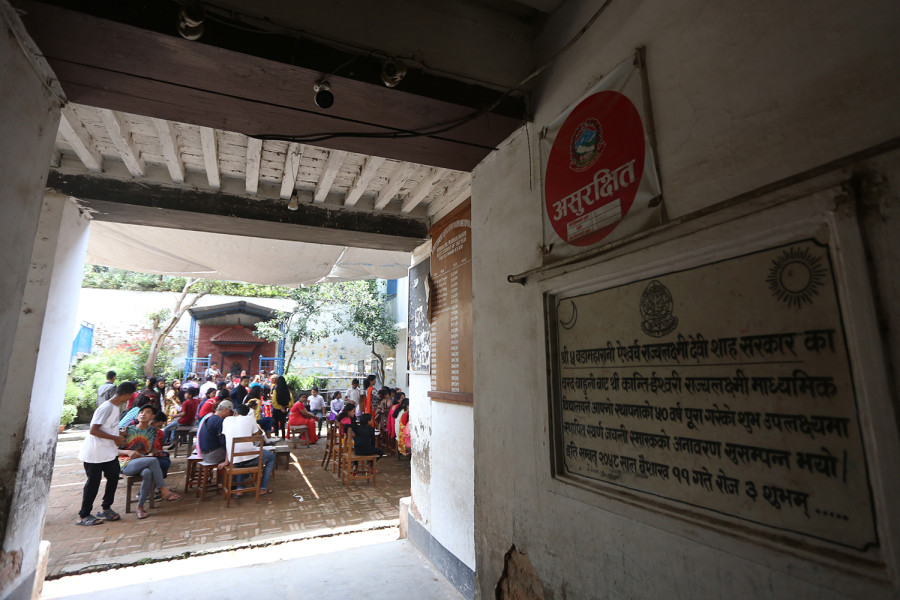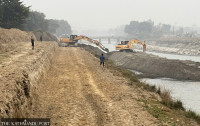National
Lack of land halts reconstruction of around 300 quake-ravaged schools
Officials seek change in the existing building code for some schools on case-by-case basis
Binod Ghimire
In 1923, Chandra Kanta, sister of Sukra Raj Shastri, one among four martyrs killed by the Rana rulers, established a school dedicated to educating girls in Kathmandu. As the autocratic rulers were against educating the general public, she provided informal education for years before it got approved by the government.
The school, Kanya Secondary School, is the second oldest school in the Kathmandu Valley, under the general category after Durbar High School, according to the school headmaster. The school, which was initially located where the Nepal Bank Limited building is in New Road, moved to different places before it was permanently established at Yatkha in 1970.
The school had been operating from the same five-storey building until the devastating earthquake four years ago changed its story. The only building of the school was damaged in the disaster—forcing the school administration to take refuge in the premises of a nearby school. It operated from makeshift classrooms for a year, but operating from the playground of another school wasn’t easy. The school then moved back to the same quake-ravaged building that had already gotten a red sticker after a safety assessment.
For the last three years, classes have been carried out from the same quake-affected building. “We only have two options: either to quit or continue our work risking our lives,” said Gopi Chandra Paudel, the headteacher of the school, at an interaction on Monday. “It is fine if I get killed, but I am worried how I will face the parents if anything happens to our students.”
Paudel has knocked on the doors of every authority demanding the reconstruction of the risky building. But the only answer he has received is that the school lacks adequate land to receive the government grant for reconstruction.
As per the building code fixed by the Kathmandu Metropolitan City, school buildings must have six metres of spare land on each side. If this rule is followed, the school will have no land left for construction because there is hardly 3.5 annas of land under its possession.
“It is a catch-22 situation for us. We can’t say we won't follow the building code and if we abide by the rule, we will never get a new building,” Paudel added.
Records at the Central Level Project Implementation Unit under the National Reconstruction Authority show the reconstruction of around 300 public schools —damaged or destroyed in 2015 Gorkha earthquake—has been stalled because of this building code. The 300 or so schools either lack minimum land like Kanya School or don’t have land possession certificate.
The highest number of such schools—40—are in Syangja, followed by 25 in Kathmandu and 24 in Bhaktapur. Similar, uncertainty looms over the future of Bal Kalyan Basic School, in Balaju, that doesn’t have land possession certificate.
Located along the banks of the Bishnumati river, the school was constructed in public land in 1992. It never had land ownership certificates. Now as it awaits reconstruction, the project implementation unit wants a land possession certificate or guarantee from the local government.
“Requesting authorities for a new building has become another one of my duties—besides teaching,” said Arjun Sharma, headmaster at the school. Officials at the reconstruction authority say the existing criteria are binding and they cannot be allocated budget to such schools.
“We cannot go beyond government criteria,” said Im Narayan Shrestha, chief of the implementation unit. He said since local governments now bear complete authority to manage school level education, they should allocate land for such schools.
Shrestha said they are ready to allocate the budget if the local governments give official letters to allow schools to use public land. The officials at the local governments, however, said allocating land in areas like Basantpur (Yatkha) is impossible as there is no barren land left.
“The government should change the codes for special cases like Kanya School,” said Tara Pati Kharel, chief of education unit under Kathmandu Metropolitan City. “We have to be flexible to save the history of schools like Kanya.”
A total of 7,553 public schools were destroyed in the 2015 earthquakes and reconstructions of around 4,600 have been completed in four years.
***
What do you think?
Dear reader, we’d like to hear from you. We regularly publish letters to the editor on contemporary issues or direct responses to something the Post has recently published. Please send your letters to [email protected] with "Letter to the Editor" in the subject line. Please include your name, location, and a contact address so one of our editors can reach out to you.




 16.12°C Kathmandu
16.12°C Kathmandu















